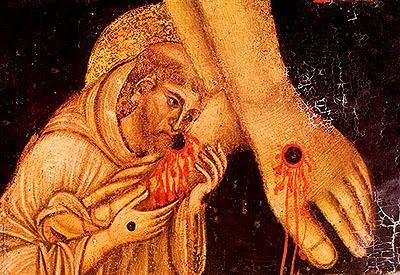The Case of the Enigmatic Relics
I could do with the services of Therese Neumann right now. Among the many supernatural gifts the German, or more correctly, the Bavarian stigmatist had was the discernment of authentic relics. I am wondering about a relic I received a few years ago from a convent on the continent which was closing down. The theca, which looks like it is 17th or 18th century, contains three relics: two of Our Lady - 'De Capilis' (from her hair) and 'De Subucula' (from her tunic) and one of St Anne which seems to be an 'Ex Ossibus' (from her bone).
Now I know what you are thinking: whatever about the relic of St Anne, the other two must be fakes. Well, actually, it's not as cut and dry as that. It seems there is a tradition of relics of Our Lady surviving, her Veil preserved in Chartres Cathedral being one. There are also alleged relics of an undergarment (tunic or subucula) and a belt. Plausible, I hear you say? Perhaps. The Apostles or disciples could well have preserved some of her clothing after the Dormition and Assumption, and these could have been passed down to us. But her hair? I thought we could draw the line at that, but it seems not.
I'm told that relics of Our Lady's hair were preserved in Constantinople, and from there came to the West. Constantinople was known to be a treasure trove of relics, particularly those relics which originated in the East, including of relics of the Lord, Our Lady and the Apostles. Following the Sack of Constantinople in 1204, many of these relics were taken to the West - many to what is now Italy, and enshrined in churches. This is how some of the Eastern Doctors of the Church ended up in the West. Apparently, according to some sources, strands of Our Lady's hair were brought to Constantinople from Nazareth - they had been preserved by Christians in the house of the Holy Family there. Like other relics, the hair also came West and particles were enclosed in reliquaries and distributed.
Is this true? Well, as you would expect, it is disputed. Constantinople or Byzantium was a great city of artifice, corruption and deceit, there is no reason to expect that the Church and her treasures were immune from such traits. In a paper read at the Ecclesiastical History Society in Cambridge in 1972, Derek Bethell, a medieval historian at UCD in Dublin, as he discussed a relic collection held at Reading Abbey in the Middle Ages, dismissed the authenticity of hair relics of Our Lady, and those of her bed and belt. He also discouraged credibility in relics of Moses and Aaron (their rods), the Lord's shoe, swaddling clothes, bread from the feeding of five thousand and the Last Supper, and, indeed, Blood and Water which issued from his side on the cross, and others which also strain credibility. These, he suggests, are fakes dating from the Third to Sixth centuries. However, he also dismisses Veronica's Veil, relics of the Apostles and St Anne for which there is a provenance.
Without doubt, many relics out there are fake. There was a roaring trade in relics in the Middle Ages, and if a particular city, cathedral or church could not steal the neighbouring parish's relics, they may well have resorted to more desperate means to ensure the nobility of their ecclesiastical patch was enhanced with a rare relic. It was all about prestige, pilgrims and pelf. The Church is very careful about relics and their authentication, and while it falls on the side of tolerance for ancient relics that could well be authentic, as long as there is a credible provenance, she is a stickler when it comes to more recent relics and their authentication. The recognitio of a Blessed or a Saint, for example, is governed by a whole host of rules and if relics are taken to be prepared, the bones can hardly be seen for the wax employed in the official seals to prove they are authentic.
So, what about the three currently under scrutiny here? Well, I had left them aside since I got them and I am looking at them now with a critical eye. There is no certificate and the seal is the worst for the wear (not a good sign), but then they have been in a convent for centuries. That does not mean they are genuine, but it does mean that some budding entrepreneur has not been rubbing cold tea over a snippet of curtain, mother's hair and a piece of the T-bone steak to flog it on Ebay. Sadly, it does not rule out a medieval huckster getting one over on the good sisters. As I said, it is a case for Therese Neumann.
However, if any of you out there have any ideas, insights or information, please let me know. Comments are enabled.



Comments
Post a Comment